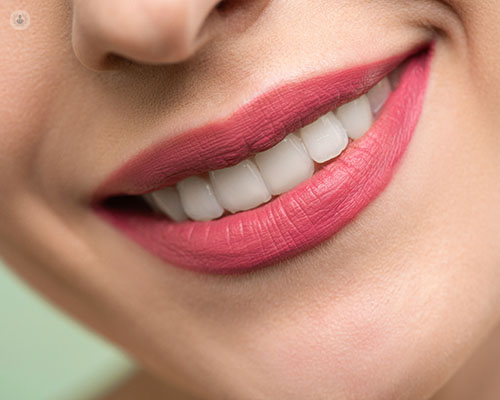Composite bonding: an expert’s guide
Escrito por:Composite bonding is a dental procedure that can be used for both cosmetic and restorative purposes. In her latest article, renowned dentist Dr Rachel Mulholland offers her expert insight into the procedure.

What does composite bonding do?
Composite bonding is a procedure which involves adding white filling material to the edge or part of the tooth. This can be done to replace worn enamel or used for cosmetic purposes. Composite bonding can improve a smile by creating symmetry and restoring the teeth to their natural shape.
It can also be done to close gaps and create subtle changes.
Who is a suitable candidate for composite bonding?
Composite bonding can be done to replace chipped, worn enamel which can appear translucent and uneven due to tooth wear.
Misshapen teeth can be improved with composite bonding as the material can be placed to transform the shape and size of a tooth.
Suitability will also depend on the patient’s periodontal condition, occlusion and oral hygiene.

How do you maintain composite bonding?
- Maintain excellent oral hygiene and flossing
- Regular visits to the dentist for check-ups
- To avoid chipping – avoid the habits of nail-biting, chewing hard materials
- To avoid staining/ discolouration – be mindful of lifestyle and high-staining foods especially red wine, curry, black tea/ coffee, smoking
- Some individuals may be advised to wear a mouth guard at night time to help prevent clenching or grinding damage the composite
How long does composite bonding last?
There is no specific length of time that composite bonding lasts. It can vary from a very short time to a very long time depending upon many conditions existing from patient to patient, and/or upon each patient’s individual habits or circumstances. This includes their oral hygiene, diet and how often they go for dental check-ups.

Does composite bonding damage your teeth?
Composite bonding is a minimally invasive procedure. No natural tooth is damaged or removed throughout the treatment. Material is added to the tooth and it is then the material that is shaped and carved to improve the shape.
The only thing to be aware of is that composite material is not as strong as natural teeth, therefore there is a possibility for the material to chip or separate from your real tooth.
When and how is composite bonding removed?
Composite bonding may have to be removed and replaced in severe discolouration cases or when the bonding has come to the end of its functional lifespan and there have been continuing breaks and chips.
Composite bonding can be removed by a dentist with their dental tools and instruments without damaging the teeth.
If you are interested in composite bonding, or any other dental procedure, you can book an appointment with Dr Rachel Mulholland via her Top Doctors profile.


